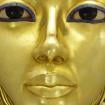Tutankhamun and the Age of Appropriation: Missing Skullcap of the Last Sun King–Part II
The oft-repeated phrase “the Amarna era is shrouded in mystery” could be a thing of the past if only closer scrutiny of key artifacts from Tutankhamun’s tomb are permitted by the authorities concerned. Courtesy reuse and usurpation, the cleverly disguised inscriptions can yield a wealth of information on the political and religious upheaval of that period, and enable us to peer through the mists of time to gain accurate insights into one of Egypt’s most puzzling epochs. Among the plethora of KV62 mysteries, a modern one exists in the form of Tutankhamun’s missing skullcap.

Brilliantly painted Talatat blocks reveal a glimpse of the splendor of Amarna art. (Top) In his role as High Priest, Akhenaten makes offerings of food and worships the Aten. In the scene below, the pharaoh revels in the rays of the sun as he venerates the solar disc. Luxor Museum. (Photos: Petra Lether)
TAINTED GOLD AND FORGOTTEN KINGS
Dr Nicholas Reeves proposes that as co-regent, Nefertiti adopted a kingly name: Ankhkheperure Neferneferuaten. And when Akhenaten died in Regnal Year 17 she succeeded as independent pharaoh, her name now changed to Ankhkheperure Neferneferuaten Smenkhkare-Djeser-Kheperu.

A close-up of a limestone relief shows an extraordinary representation of Queen Nefertiti smiting a female captive on a royal barge; a depiction reserved only for male pharaohs. Museum of Fine Arts, Boston. (Captmondo/CC BY-SA 3.0)
Revealing details from his studies, Dr Aidan Dodson writes, “In 1998, French Egyptologist Marc Gabolde pointed out that a number of cartouches of Neferneferuaten that had been read as using the epithet “Mery-Akhenaten” actually bore the epithet “akhet-en-hi-es” —“effective for her husband.” The correctness of these readings by Gabolde was confirmed beyond any doubt by exhaustive reassessments of the palimpsest (or altered) inscriptions inside the canopic coffinettes ultimately used for Tutankhamen, which had long been known to have been usurped from Neferneferuaten: wherever the epithet could be detected, it was indeed “akhet-en-hi-es.””

Such scenes are extremely rare in Egyptian art; in fact, these constitute the only examples of a king and queen sharing intimate moments. But, when Akhenaten came to the throne he dictated the course of art—the results are staggering as they are impressive. (Neues Museum, Berlin and Brooklyn Museum, New York.)
But why would a new ruler, such as Tutankhamun, use his predecessor’s grave goods? Reeves proposes that burial objects intended for Ankhkheperure Neferneferuaten could possibly have been discarded unused “either because the items had been superseded by funerary equipment inscribed for Nefertiti in her final incarnation as Ankhkheperure Smenkhkare, or else because Nefertiti, for whatever reason, was never buried in kingly style,” and adds, “Several objects from the tomb had demonstrably been intended for use by earlier kings; and, although the original ownership of many of these appropriated pieces cannot always be established, a good number of pieces had clearly been designed for Akhenaten or for his coregent and probable successor, the enigmatic Smenkhkare.”

Front and back views of one of four elaborately decorated canopic coffinettes that held the royal viscera of Tutankhamun. Palimpsest inscriptions chased inside these objects reveal the name, Neferneferuaten. The Egyptian Museum, Cairo.
ART OF RECYCLING
For Egyptologists, the process of use and reuse is not entirely unfamiliar: indeed, it was destined to be repeated three centuries later when the Valley of the Kings itself was dismantled, the royal mummies cached, and a selection of their tomb contents taken over for the burials of the 21st Dynasty kings at Tanis. “Although the dismantling of one’s forebears’ tombs and the re-employment of second hand burial equipment seems a rather grotesque concept, it was clearly common in ancient Egypt. During the Third Intermediate Period, at the time of the great caches, the motivation varied. It is clear that the Egyptians considered certain items of funerary equipment to be imbued with a magical potency which could be transferred to its new owner,” explains Reeves.
This FREE PREVIEW is just a taste of the great benefits you can find at Ancient Origins Premium.
Join us there ( with easy, instant access ) and reap the rewards: NO MORE ADS, NO POPUPS, GET FREE eBOOKS, JOIN WEBINARS, EXPEDITIONS, WIN GIFT GIVEAWAYS & more!
- Unraveling Tutankhamun’s Final Secret: Cloak of Mysteries Reside in a Sepulchral Masterpiece–Part I
- A Curious Case of Linen for Papyri—Lifting the Veil off the Lack of Written Materials in Tut's Tomb
- Daughter of Disaster: Unsung Ankhesenamun
Independent researcher and playwright Anand Balaji is an Ancient Origins guest writer and author of Sands of Amarna: End of Akhenaten.
Top Image: Collection of Egyptian Art, design by Anand Balaji (Photo credits: Heidi Kontkanen, A. Parrot, Stefano Merli, Jean-Pierre Dalbéra and Richard Dick Sellicks); Deriv.
By Anand Balaji




















